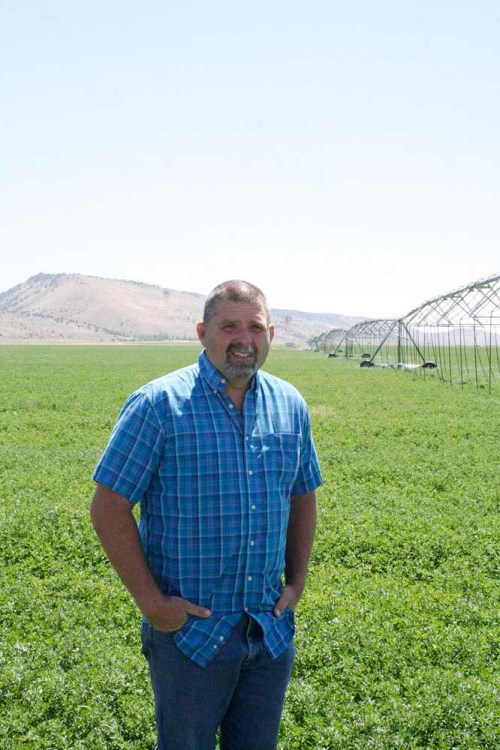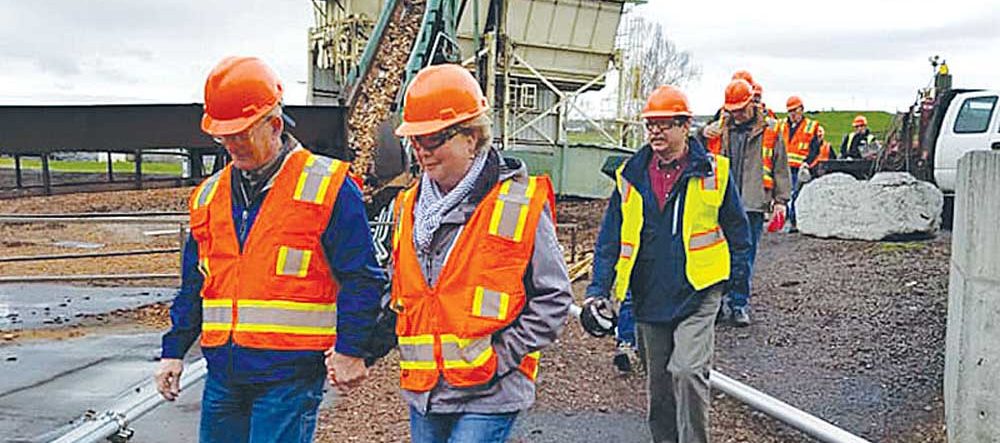‘A rudderless ship:’ Irrigators struggle with Oregon water policy
Published 7:00 am Thursday, July 28, 2022

- Mark Owens, R-Crane, vice chair of the Oregon House Water Committee, examines his alfalfa field in Harney County, Ore., which is contending with declining groundwater levels.
HOOD RIVER — Years of work and millions of dollars invested in raising Kingsley Dam in Oregon’s Hood River Valley are about to pay off.
At least, that’s the hope of the Farmers Irrigation District, which oversaw the project and footed much of the bill.
Though the reservoir is nearly ready to store more water, the irrigation district fears it may only seldom be used at full capacity.
“We’ve built a $5.5 million reservoir expansion that we may not be able to fill,” said Les Perkins, FID’s general manager.
The project was partially funded by a $3 million state government grant, which has some complicated strings attached.
As it turns out, those hurdles may be so high that the additional reservoir volume will likely remain unfilled in many years.
The irrigation district couldn’t have expected that possibility when it obtained the grant six years ago, Perkins said.
“You just don’t know. It’s a giant black box,” he said.
Agricultural organizations worry such restrictions not only thwart the purpose of the grant program but more broadly hinder the state’s investments in water supply development.
Complications in way
“Oregon has a way to make the funding more complicated than it needs to be,” said April Snell, executive director of the Oregon Water Resources Congress, which represents irrigation districts.
The possibility of encountering expensive and restrictive obstacles can discourage irrigators from seeking state government funding, even when they lack other options, she said.
“If we want more innovative projects, there have to be fewer surprises,” Snell said.
The case of Kingsley Dam is illustrative of the problems cited by critics.
Because the irrigation district accepted the grant money, its new storage water right is subject to stricter environmental conditions.
Additional water can only be diverted into the reservoir during winter if affected stream levels rise above thresholds set by state regulators.
This “seasonal varying flow” requirement is intended to protect fish.
Elevated water levels are needed for adult fish to swim upstream and for juveniles to move downstream. High flows also flush unwanted sediments from spawning habitat and maintain stream channels, among other functions.
The Farmers Irrigation District knew the grant money entailed “seasonally varying flows” and other requirements, such as devoting 25% of the newly stored water for in-stream uses.
However, the irrigation district could not have predicted the exact flow thresholds until the Oregon Water Resources Department completed its analysis of stream data.
While the OWRD’s experts believe the reservoir’s chances of being filled every year top 90%, the irrigation district is skeptical due to its experience with water levels in the affected streams.
“Our concern is we don’t feel like we see those flows very often,” Perkins said. “We have concerns that reality is not going to match what the models are saying.”
If the flow thresholds could be adjusted based on new and more reliable stream data, the problem could be resolved, said Megan Saunders, the irrigation district’s watershed project manager.
Unfortunately, the OWRD has told the irrigation district that the conditions on its new water storage right cannot be modified based on updated information, she said.
“Some way to incorporate actual reality would be nice,” she said.
Climate change ignored
Though Oregon’s government wants to be proactive against climate change, critics say this rhetoric hasn’t been reflected in its efforts on water policy.
If the state’s leadership is serious about facing the challenge, then water storage projects must compensate for reduced snowpacks, said Jeff Stone, executive director of the Oregon Association of Nurseries.
“The winter flow is going to be more important than sustained snow melt,” he said.
To anticipate such changes, agricultural and environmental groups joined forces in 2013 to convince lawmakers to pass Senate Bill 839, which created the water supply grant program.
Though the possibility of constructing “big-ass dams” is no longer realistic due to environmental regulations, the grant program was intended to create a process for smaller storage projects, Stone said.
“We were saying we should not do water storage by fire alarm,” he said.
For example, water diverted during high winter stream flows and stored off-channel in aquifers wouldn’t encounter as many environmental objections as traditional dams and reservoirs.
Over the six grant cycles the program has operated, OWRD has disbursed $35 million to 31 applicants. Only three grants, totaling about $4 million, went to projects aimed at new, increased or restored water storage.
“It’s never been implemented in a way that would allow it to succeed,” Stone said of the grant program. “I really thought by now we’d have more tangible results.”
Grants have most frequently focused on replacing open canals with pipes, which saves water by reducing seepage and evaporation. Such water conservation projects are important, critics say, but they were supposed to eventually pave the way for new water storage funding.
“It’s like a road that was planned but never paved,” Stone said. “We wanted to see if the engine would turn over, and efficiency was the easiest.”
Conservation and efficiency are commendable goals, but they can only go so far for irrigators with insufficient water supplies, said Snell of OWRC. “You can’t conserve what you don’t have, and that’s the challenge for a lot of these areas.”
‘Unmitigated disaster’
If the underlying grant fund bill represented a victory for compromise, the rule-making that followed demonstrated how easily such deals can unravel.
“Rule-making was an unmitigated disaster,” Stone said. “Rule-making is where good bills go to die because everyone re-litigates all they wanted in the first place.”
Disagreements over water storage reflect a fundamental difference in perspective.
For farm organizations, declining snowpacks are a prime argument for new water storage. For environmental groups, climate change is a major reason to be cautious about such projects.
“We’re moving into water regime we don’t fully understand, and we don’t understand our water needs even under the current regime,” said Karen Lewotsky, rural partnership and water policy director for the Oregon Environmental Council.
“We need to clearly understand the system — the hydrologic regime — we’re going to be affecting if we do build storage,” she said.
Furthermore, environmental advocates say it’s not unreasonable for irrigators to make concessions in return for taxpayer dollars.
“This is public money. This is not private money. There needs to be a public benefit to those public dollars,” said Kimberley Priestley, senior water policy analyst with the Waterwatch of Oregon nonprofit. “They can go elsewhere and they’re not subject to the same standard.”
Few water storage grants
Disputes over water storage haven’t stopped such projects from receiving grant money — at least, not directly.
The lack of water storage grants isn’t the result of OWRD rejecting such applications, said Kim Fritz-Ogren, the agency’s water resources development program manager.
“We’ve received very few that are storage proposals,” she said. “I don’t hear a lot about a lot of storage projects being pursued, but why that is, I don’t know.”
The Oregon Farm Bureau isn’t surprised that more farmers and irrigation districts haven’t applied for water storage grants, despite the need for such projects.
State regulators don’t understand what it takes “to make a project pencil,” while grant rules effectively preclude many storage proposals from being economically feasible, said Mary Anne Cooper, the group’s vice president of government and legal affairs.
“It’s easy to bog down a program with so many environmental conditions that it can’t meet its goals,” Cooper said. “Our agencies are myopically focused on enforcing the regulations and have lost sight of the bigger picture.”
Lack of interest?
Critics say the water supply grant program isn’t the only example of Oregon’s feeble response to the challenges faced by irrigators and other water users.
Lawmakers authorized OWRD to make $40 million in loans for water supply development during the 2015-2017 biennium. However, the agency didn’t make a single loan due to insufficient “stakeholder interest.”
“There can be a number of reasons there’s a lack of interest in loans, depending on the entity, but a common one is concern about the ability to pay back the loan,” said Fritz-Ogren of OWRD.
The dearth of loan applications didn’t reflect a shortage of potential demand, said JR Cook, founder and director of the Northeast Oregon Water Association.
Rather, irrigators were wary of borrowing money from a state regulator, he said.
Cook’s organization has facilitated the construction of two pipelines to carry water pumped from the Columbia River to irrigators in the Umatilla Basin.
The pipelines draw water from the river in equal measure — “bucket for bucket” — to water saved upstream through efficiency improvements.
The two pipelines cost $85 million to build, including $11 million in state money directly authorized by lawmakers in 2015.
The association decided against borrowing any money from OWRD, afraid it would impose provisions that would hamstring the projects financially, Cook said.
“By placing it through a regulatory agency, with all these extra nuts and bolts, it makes that funding inaccessible,” he said. “We are taking too much risk by saying we can comply with the conditions on the loan and repay the loan.”
Innovative irrigators are prepared to be the “guinea pig” for new water strategies, but the state can’t expect them to do it at a financial loss, Cook said. “Sometimes, you need to feed the guinea pig, or it dies.”
Cook’s organization is now planning for the construction of a third pipeline to recharge an underground aquifer and serve agricultural, municipal and industrial water users.
Though the state’s grant program could potentially pay for the facilities needed for aquifer recharge, it cannot cover operational costs.
Pumping the water and testing the strategy would annually cost about $1 million for five years, but further investment cannot move forward without those prerequisites.
No investor or lender will touch a project that’s as yet uncertain to generate revenues through water withdrawals, said Gibb Evans, vice president of IRZ Engineering & Consulting, which is involved in the project.
Those cannot begin until the recharge and storage methods are proven, Evans said.
“You can’t do the recovery piece, so nobody is going to pay for that,” he said. “It’s like a car without tires on it. Unless you buy that last piece, it can’t go anywhere.”
Cook believes it’s in the state government’s interest to help fund the project, so he plans to seek an appropriation from lawmakers.
However, he said, it’s unfortunate Oregon doesn’t have a coherent funding system for such investments.
The OWRD’s “integrated water resources strategy” consists of vague objectives rather than concrete steps that can guide spending, Cook said.
Without a clear-cut path for investing, lawmakers approve haphazard water spending proposals that aren’t tied to actual “deliverables,” he said.
“It’s a rudderless ship,” Cook said. “There’s nothing to base that decision on.”
Game plan missing
Such criticisms are not limited to the farm industry.
The Freshwater Trust, a conservation nonprofit that pushed for the water grant program, also wants a more cohesive game plan for water investments.
“Every deal is a one-off and it doesn’t add up,” said Joe Whitworth, its executive director. “They’re not really focused on overall outcomes.”
While Whitworth says no state government is truly prepared for future water problems, Oregon’s “integrated water resource strategy” isn’t much of strategy at all.
“Our ability to execute against it meaningfully is demonstrably not meeting the needs of the state, and it’s not going to,” he said. “It’s just not utilizing tools that will make it real.”
Oregon would benefit more from an “analytics-driven” process to steer funding toward specific targets, with a clear way to measure success, Whitworth said.
“What is the biggest bite out of crime we can take while spending the least amount of dollars?” he said. “We need to describe the world we want and pursue it.”
Questions that once seemed hopelessly complex can now be quickly resolved due to massive advances in computing power, Whitworth said.
“We’re able to see things in a way we’ve never seen before. We can now play ‘Moneyball’ for watersheds,” he said, referring to the strategy a Major League Baseball team used to analyze which players would produce the most runs for the least amount of money.
‘Room for improvement’
Tom Byler, OWRD’s director, agrees there’s “always room for improvement” at the agency — but he says it’s important to keep certain historical contexts in mind.
Lawmakers eliminated funding for OWRD’s dedicated planning division more than 30 years ago, he said. During lean budgets in the past, prospective future water shortages may not have felt urgent.
“I don’t think we were as aware of the limitations on the resources as we are today,” Byler said.
Grants for water supply projects are required by law to meet social and ecological purposes as well as economic ones, all while complying with existing state and federal regulations, he said.
If requirements such as the “seasonally varying flows” aren’t working as intended, OWRD is willing to discuss potential improvements, as well as the agency’s authority to make such changes, he said.
“We are open to those conversations,” Byler said.
Water regulators are bound by parameters set forth in law, he said.
For example, the state constitution imposed constraints on the $40 million that lawmakers authorized for water loans, Byler said. “We do not have a lot of latitude in how we administer the program.”
Lawmakers involved in water policy acknowledge Oregon’s shortcomings but say those problems aren’t being ignored.
“I think our agencies are accepting that we’re entering a long-term period of water scarcity,” said Rep. Ken Helm, D-Beaverton, the House Water Committee’s chair. “Water has to be a ‘top-five’ priority for the next governor and the next several legislatures.”
Oregon’s next governor should also install a “water czar” who’s able to coordinate the state’s water initiatives, Helm said.
“We need leadership directly from the governor,” he said. “There’s no substitute for that.”
Oregon has numerous natural resource agencies that deal with water to varying degrees, but there’s currently too little cooperation between them, Helm said.
“It’s not built into their agencies. It’s not built into their budgets,” he said. “That’s a systemic problem.”
‘Place-based planning’
In recent years, lawmakers have invested in new methods of collecting data that will assist in decision-making, said Rep. Mark Owens, R-Crane, vice chair of the House Water Committee.
Lawmakers must also build on the “place-based planning” approach adopted in past legislative sessions, he said. Communities have been developing region-specific water plans but currently lack the authority to carry them out.
Such community-led proposals won’t do much good unless they’re put into action, Owens said. “If we can’t figure out place-based implementation after we plan, we fail.”
In general, water solutions with a broad consensus are more likely to be successful, said Snell of the Oregon Water Resources Congress. The time for striking such deals is now, however.
“It’s not going to get any easier,” she said. “There will not be more water in the summer time or fewer conflicts between entities.”









